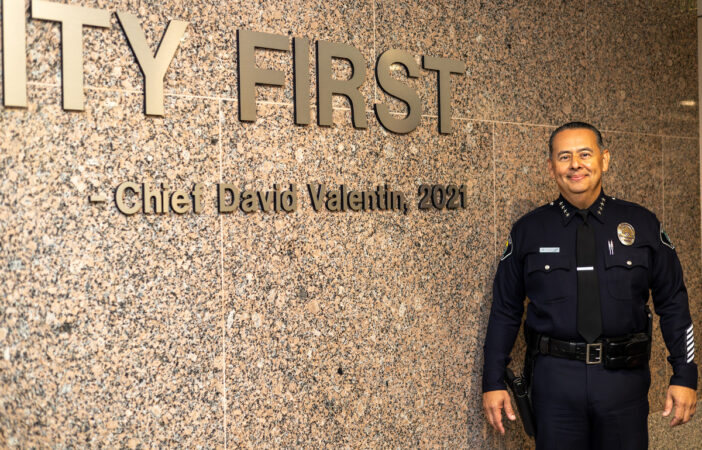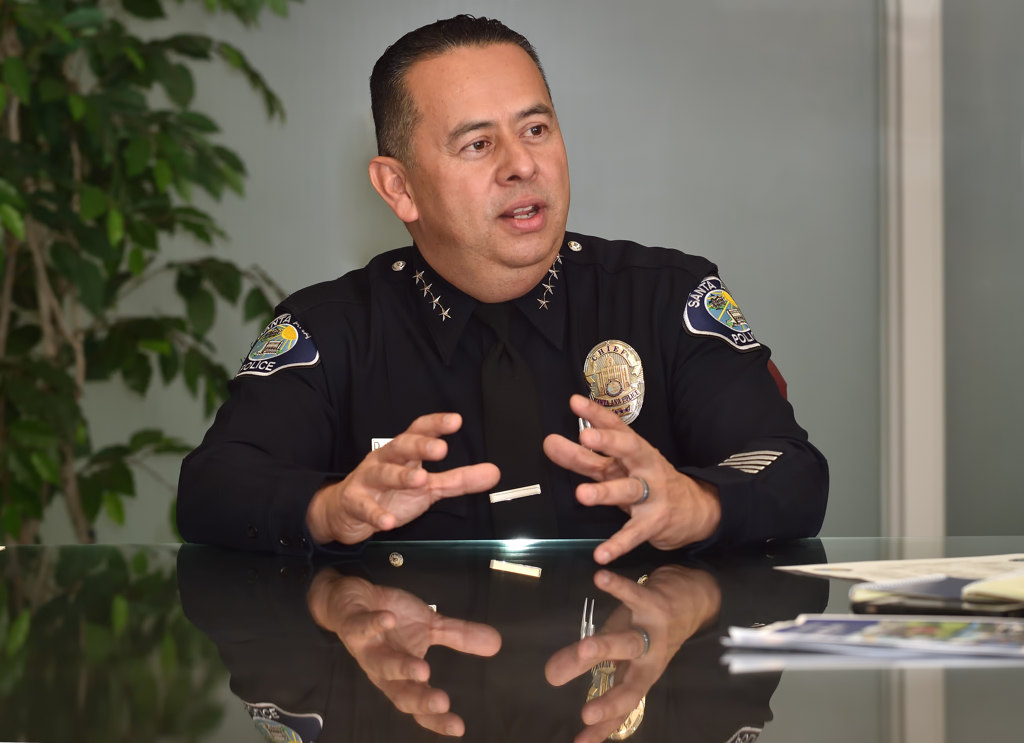“Community first” has become the mantra of the Santa Ana Police Department. The phrase is emblazoned on walls inside the police station. It’s the first thing you see on the agency’s website and is featured prominently in the community events the department stages.
To retiring Chief David Valentin, who coined the phrase two years ago, it is a simple message that Valentin says encompasses the “ethos and framework” of the department.
“At the end of the day, why are we here?” Valentin asked. “The reason we’re here is to serve our community. If we put our community first, good things come from that.”

After 33 years, Chief David Valentin removed his Chief’s 4-star insignia and worked Cover Watch II Patrol into the night, with his Chief of Staff/Adjutant Sgt. Alex Lopez, patrolling the same streets as a rookie patrol officer.
Photo provided by the Santa Ana Police Department
On Thursday, Nov. 2, the department will stage a Last Roll Call and Retirement at the police station at 2:31. The two signifies when the second-watch roll call is held, and 31 is for the Santa Ana station number.
The agency is saying goodbye to the city’s first homegrown and second Latino Chief after 33 years in law enforcement, and six years at the helm.
In that time, Valentin and the department, building on the groundwork laid by previous chiefs, won numerous accolades for progressive and community-oriented efforts in the often fractious seat of Orange County.
Through his tenure, Valentin navigated a careful path between the authority and enforcement side of policing, and the more progressive, social service model.
“From day one, I focused our department on that dual policing framework, that is community based and traditional policing,” Valentin said. “Those very much complement each other. We absolutely need to be focused on community based policing, which is one-on-one relationship building, and traditional policing. We can never get away from that.”
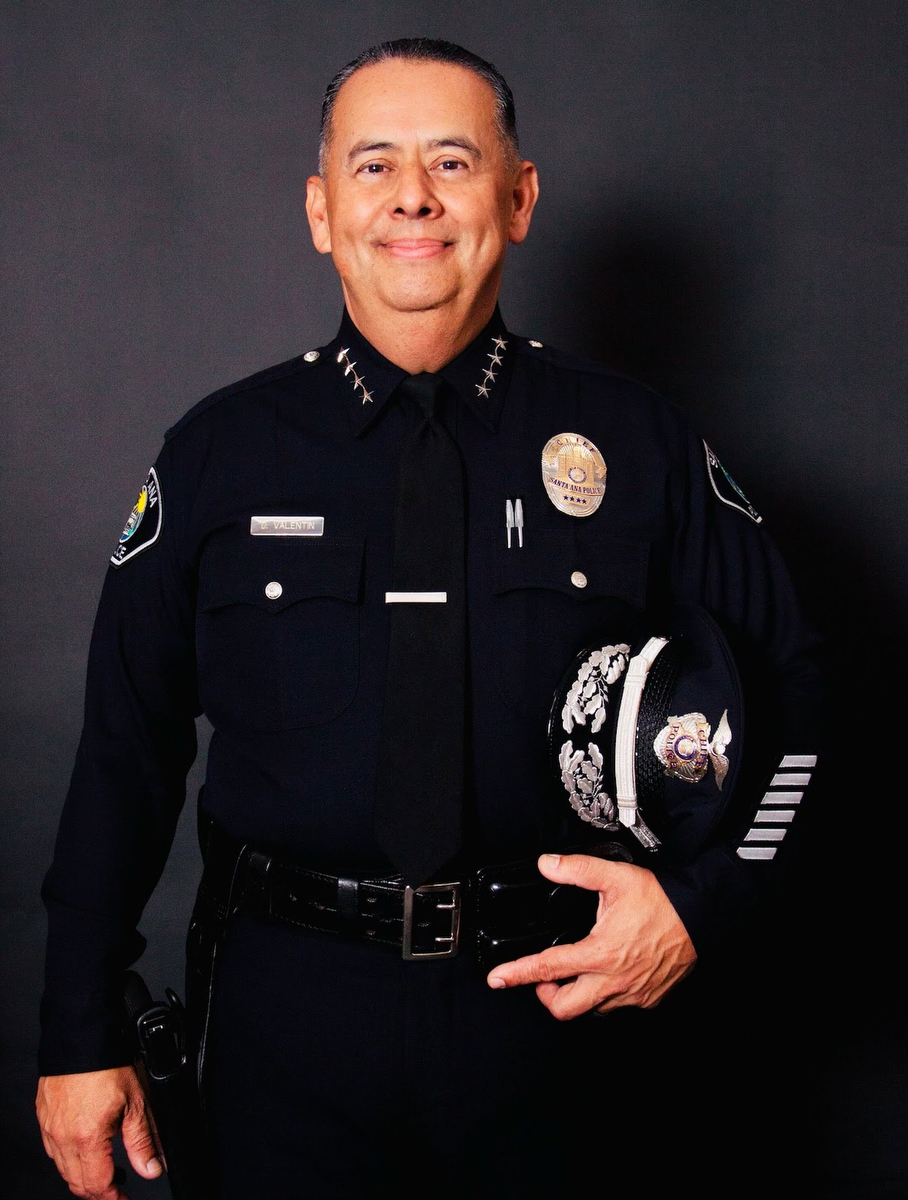
After 33 years, Chief David Valentin is retiring from the Santa Ana Police Department.
Photo provided by the Santa Ana Police Department
In a time when public opinion on police reform has see-sawed between calls to defund and refund agencies, Valentin has worked to maintain a fragile equitability.
“It is incumbent on modern leadership to balance these two paradigms that have to exist together,” he said. “One cannot exist without the other. They won’t be successful.”
Spit and shine
A self-described “traditionalist,” Valentin loves the look of police officers in full regalia and the message that sends.
“I prefer seeing officers in their Class A uniforms, in wool and highly polished equipment,” Valentin said. “It starts with a professional presence. The community sees it and acknowledges it. We hear it all the time.”
For this reason, early in his tenure as Chief, Valentin came up with an unusual idea to lift the flagging spirits of a department with a 20 percent vacancy.
Valentin called for an “all-hands-on-deck” inspection for sworn personnel in front of the police department headquarters.
“We hadn’t had an inspection with all sworn officers in over 30 years,” Valentin said. “It was a heavy lift. We had to call in three neighboring agencies to take calls for service (during the inspection).”

Soon after becoming Chief of the Santa Ana Police Department, David Valentin held an inspection of all sworn officers in the department.
Photo courtesy of the Santa Ana Police Department
However, the event had the desired effect, building esprit de corp and camaraderie, he said.
Valentin said he also bucked the trend in the wake of the murder of George Floyd, the growth of the Black Lives Matter movement, and during the height of the Covid-19 pandemic. As tensions between the public and the police became acute, a number of departments pulled back.
Valentin went the other way.
“We saw the calls for police reform and the defund the police movement,” he said. “We went in the reverse. We deployed additional resources to the field.”
As an example, Valentin said when many other agencies were having detectives work from home, he assigned them to the field to relieve beleaguered street cops.
“I’m proud to say we did that,” Valentin said.
Community initiatives
On the flip side of enforcement, Santa Ana Police Department has prided itself on being a pioneer in community policing, dating back to policies implemented by former police Chief Ray Davis in the 1970s.
One of Valentin’s early projects, he said, was to create a five-year strategic plan with the assistance of the Orange County Human Relations Commission and input from the public in community meetings. The plan built upon the existing Community-Oriented Policy to “deliver policing equitably to everyone in our city.”
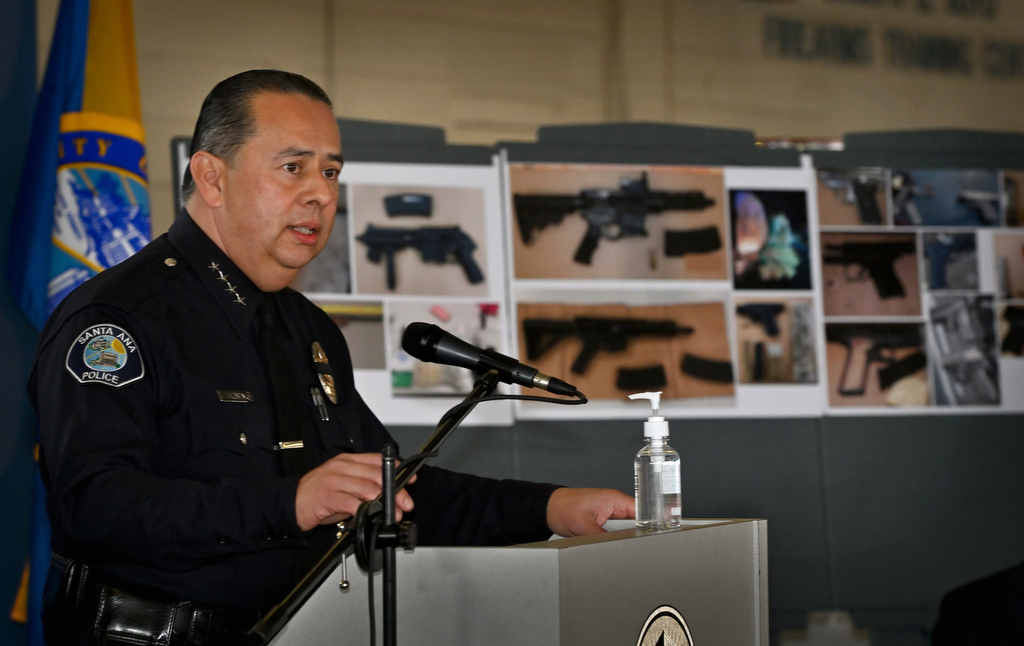
Responding to a year to date increase in violent crime and homicides in 2021, Santa Ana Police Chief David Valentin talks about the department’s response with Operation Community First.
File photo by Steven Georges/Behind the Badge
Throughout his tenure as Chief, Valentin and the department have undertaken a number of diverse and far-reaching initiatives, and the department has been recognized as being at the forefront of diversity recruitment and was the only Orange County agency awarded a Department of Justice Community Oriented Policing Office Hiring Grant in 2020. Santa Ana Police Department is also part of the national 30×30 Initiative to increase the percentage of sworn women police officers to 30 percent by 2030. Santa Ana also established the first therapeutic canine program in Orange County with focus on employee and community wellness.
Under Valentin, the police department launched what city officials described as a first-of-its-kind Family Justice Center, aimed at connecting victims of domestic violence with services like obtaining restraining orders.
“That was long before calls for police reform,” Valentin said. “It’s not a reaction to that. It’s been a platform of ours for quite some time.”
A destination department
While many police agencies struggle to fill their ranks, particularly with quality candidates, Valentin has been proud of the work of his department, which is at 93 percent capacity. Santa Ana has cultivated a dynamic hiring strategy that blends experienced lateral hires with locally cultivated recruits.
Santa Ana also offers generous salaries with incentives for those with added education, training, and skills, such as bilingualism and multilingualism.
“We have always been a destination agency.” Valentin said. “It’s important to invest the time and the dollars necessary to recruit and build a bridge.”
Unlike departments that may have lowered standards to attract applicants, Valentin says, “when I took over as chief in 2017, we actually increased our standards.”
These included one-on-one interviews with the Chief, which Valentin said had not been in place for many years.
“It takes us longer to recruit and then fill the vacancies, but I’d rather do it that way,” he said.

The Santa Ana Police Department earned regional and national attention after Chief David Valentin staged an inspection for all its sworn personnel.
Photo courtesy of the Santa Ana Police Department
Personal challenges
Despite the high marks and recognition, Valentin’s tenure has been anything but smooth. For most of his years as Chief, he has been embroiled in disputes with the Police Union and its controversial former president Gerry Serrano. A central figure in the resignation of former chief Carlos Rojas, Serrano had a history of confrontations with police and government leaders, leading recall campaigns and making disputed and ultimately unfounded allegations.
Asked about his biggest challenges, Valentin said, “How much time have you got?”
Although he did not mention Serrano, who recently retired, Valentin said he had to battle against “interest groups, private agendas that cross over into why we’re here. We’re to serve and protect the community. We’re not here to be redirected to certain personal agendas.”

Anaheim Police Chief Jorge Cisneros and Santa Ana Police Chief David Valentin greet each other at Lucille’s Smokehouse Bar-B-Que in Santa Ana as Chief Cisneros came to congratulate SAPD’s Baker to Vegas team and make good on a bet in 2019.
File photo by Steven Georges/Behind the Badge
In July, Attorney General Rob Bonta declined to initiate criminal charges against Valentin after receiving a series of letters from the Police Officers Association in 2022 requesting an investigation. Serrano also unleashed a no-confidence vote against the Chief as part of his campaign.
“You have to have internal fortitude and ability to stand for what’s right, even when you are criticized relentlessly beyond anyone’s imagination,” Valentin said. “It’s unfortunate I spent a lot of my time on distractions involving labor groups that really are self-serving and lost focus on why we’re here. We’re not here to line our pockets and disregard the average person who truly needs help.”
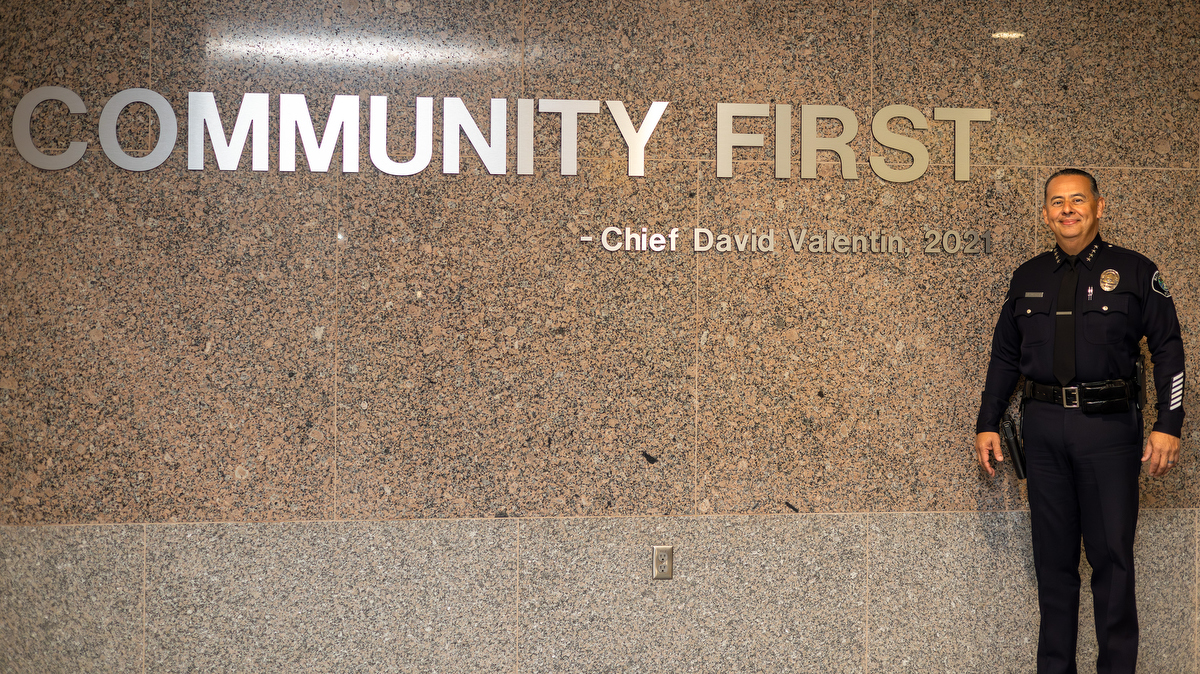
Santa Ana Police Chief David Valentin poses at the Santa Ana Police Department on October 26, 2023, ahead of his retirement ceremony. Photo by Sarahi Apaez/for Behind the Badge
Good scar tissue
The Chief likes to say his life experiences have given him “good scar tissue.” Valentin could have retired years ago but said, “I stayed on to secure vindication, and I have that based on the courts.”
However, Valentin’s fortitude was built long before he entered law enforcement. It began, he said, when he was a pallbearer for his best friend, who was killed in a drive-by shooting and whose mom pleaded with Valentin to be different. To “represent different.”
His fortitude was baked in when he was denied acceptance into the Police Explorers.
“I was devastated,” Valentin says. “I was 14 or 15. The people I hung out with were … problematic.”
Valentin asks rhetorically, “Why am I here? Someone who should have been killed on the streets of central Santa Ana, like many young men I grew up with. Or why wasn’t I sent to prison behind some law violations? There’s a reason I was given this opportunity, now what am I to do with it?”
He found the answer in two words: “Community first.”
 Behind the Badge
Behind the Badge
